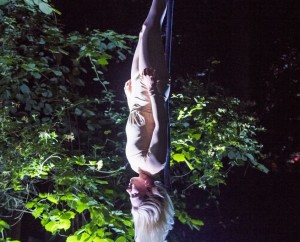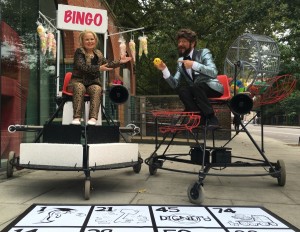‘So what’s the difference between site-specific and site-responsive?’ asks a colleague, as we wait on the platform of the eastbound Jubilee Line at London Bridge station. Deep breath. I say straight away that I try not to be too pedantic. I know that most people just say ‘site specific’ for all work outside of theatre spaces, and I go along with it a lot of the time, not wanting to be a definitions anorak, but if left to my own devices to choose the terminology, I tend to use ‘site responsive’. For me, it works as a broader term, to denote work that could respond to site in any one of numerous different ways – and so much work that is labelled ‘site specific’ isn’t necessarily completely specific to that site.
As an example, I say, looking around, if I were to make a piece of work that was site-specific to London Bridge station then perhaps it would take in the history, geography, psychogeography even, of that site. It’d be about London Bridge station – the place, and perhaps also the people that use it – and set in London Bridge station. That would be one type of response to the site, a response specific to that place. I could, on the other hand, make a piece sited in the station that was about travel and transience, and/or a choreographic piece using the escalators and stairs and lobbies, and that would be a response to that site, but could be moved on fairly easily to other stations. And of course example A could and probably would incorporate elements of example B, because why wouldn’t you use everything/ do everything the site offered?
That was quite enough for a brief chat while waiting for a Tube train. Saying more would move into trainspotter territory, but it set me musing. I started thinking about the time – what, almost 20 years ago? – when I had asked the same question of artist/writer/dramaturg, and now legendary mythogeographer, Phil Smith. When I started editing Total Theatre, he kindly wrote a rather splendid article about his company, Wrights and Sites, and their Mis-Guides to Exeter – then a programme of live performative walks, now a series of books encouraging us all to drift and derive daringly around our hometowns, and anywhere else we find ourselves. Phil also, around that time, put me in touch with his Wrights and Sites colleague Simon Persighetti, who had made a rather nifty chart explaining site-specific and other forms of site responses, including (now we really are getting anorak-y) ‘site generic’ work, which is a way of describing example B above – work that is suitable for a genre of sites: railway stations, for example, or children’s playgrounds, or hospitals. Or in the case of my company, The Ragroof Players, ballrooms, bandstands, or boxing clubs.
Thinking of the work I’d seen in this year’s Brighton Festival and Fringe, there’s much to reflect on about site and siting. There’s the work that aims to be site-specific, and the work that is sited outdoors but not specifically to any one site, and the wandering walking work, and more…
So, all aboard – let’s go for the obvious as a first stop. Five Short Blasts: Shoreham (by Madeleine Flynn and Tim Humphrey) was made in collaboration with Shoreham’s water communities – those who live by the sea or on the banks of the River Adur. It was first made in the port of Melbourne (Australia) and remade in Shoreham (West Sussex). So it’s a site-generic show if we want to use that tag – a piece set on a boat that can move from place to place – but then becomes specific to each new place (just to ruffle up our definitions). Things then went off into another direction when, for various technically watery reasons, the whole thing got moved to Brighton Marina. Interesting! It worked, though – once I’d decided that I’d view it as a map of Shoreham misguiding us across the waters. If you’d like to know more, read here.
For the Birds was a Brighton Festival exclusive, set in the woods of Hollingbury – a night-time walk experiencing the delights of sound and light installation works by Mark Anderson, Jony Easterby, Kathy Hinde, Ulf Pederson, and Pippa Taylor. I had, in fact, seen some of the Jony Easterby contributions as part of Inside Out in Dorset last year, but that was not only another time and place, but also a daytime event – so it’s a very different experience here. Where better to site installations about birds than amongst the trees in a wood, you might think – although that wasn’t everyone’s opinion. There were grumbles about the fact that May is nesting season and this installation would thus disturb the birds. Countering that, other people argued that city birds manage, with traffic noise and street lights and all sorts. Human beings constantly impose themselves on the landscape with our homes and vehicles and farms and artworks and what-nots, and anyway art is always Against Nature (to steal a line from Huysmans). Discuss. I missed the press night and took myself along as a regular punter on a particularly rainy and muddy night, slipping and sliding all over the place – but glad I went. No really, I am. It was pretty, witty and wise. I loved the robot birds whizzing along, the man who could talk to the birds, the musical birdboxes whistling merrily, and the deconstructed piano triggered by light sensors.
Also a night-time adventure: Circa’s Depart is set in a graveyard – in this case, Woodvale Cemetery. I was luckier with the weather this time round (in fact everyone was – the rain held off until the last audience member on the last performance date left the site, then the heavens opened making the get-out for the crew a bit of a nightmare – yes, I have insider knowledge here). I reviewed the piece when it debuted at LIFT last year, and was keen to see how it worked in a different site. The answer is, beautifully. The show has mulched in, with some of the unnecessary trimmings ditched (including video projections on graves that detracted from rather than adding to the beauty of the London site). The large cemetery, set on a steep hill and filled with extraordinary monumental tombs, grassy banks, crunchy paths, and gnarled trees, is a gift of a site – and Circa take this gift and make the most of it. The audience are very minimally guided around by dark-clothed ‘undertakers’ with lanterns who double up as seductive choral singers. Often they stand holding lights aloft as paths fork, and we just choose which path to take – the obvious, brightly lit one that brings us close to the young women dancing on graves with wild abandon, or the darker, spookier one that moves us away from the aerialist hanging upside down from a branch, a living embodiment of the tarot Hanged Man icon, who we witness from afar. It is a great relief not to be over-ushered around the site. Often we are called from one place to another by sound or light – which is how it should be. A work that I enjoyed, with reservations, on first viewing became, when transposed to this site, a work that I loved.
Other outdoor work in the Brighton Festival included the Without Walls days in Portslade and East Brighton, which were free to audience. Whilst admiring Brighton Festival’s endeavours to bring performance work to communities who might not otherwise experience anything in the Festival, I am getting slightly tired of outdoor arts always, in recent years, being billed as ‘a family fun day out’ with minimal space in the brochure – no information on which shows appeared on which day, no photos, and in the case of Wild N Beets’ Bingo Lingo no company name given – and no proper programme of when things are on available either beforehand or on the day. It’s as if it is all just interchangeable ‘fun’ so of no importance what we see and when. I feel that outdoor arts deserves better.
So due to the lack of timetable information, I missed Wired Aerial Theatre’s new show To Me, To You, as both showings were programmed close together, early in the day (on the Saturday in Portslade). Hope to catch this one somewhere else this summer! I was on-site for almost four hours and found the afternoon’s programme a little thin, to be honest. Much of the work was not street theatre or outdoor arts, but dance pieces placed on a big black- cloth-covered stage, and a very intact fourth wall. It was also pretty unacceptable to have almost non-existent toilet and catering facilities at such a busy event. These things matter!
Of the work that deserved to be billed outdoors: Cocoloco’s Willy and Wally saw a pair of performers with heads poking out of giant ‘dresses’ made of trash, whizzing around on motorised wheels, declaiming poems and bon mots about pollution. It seemed to be very loosely based on Beckett’s Happy Days, the two characters referencing Willie and (more crucially) Winnie, who starts the play buried to her waist and ends it buried up to her neck, whilst still talking her head off. It is gently educational and mildly amusing, but it isn’t saying anything we don’t know about plastic bags and garbage mountains, although at least it is saying it in a witty and visually interesting way. It is an OK piece of walkabout (whizabout?), but it feels like a minor rather than major piece of street theatre work, and with so little else on offer it was pushed into a prominence it didn’t merit.
Wild N Beets’ Bingo Lingo is better – harnessing the joy and the kitsch of end-of-the-pier bingo and marrying it to disability politics, in a bid to make bingo a Paralympic sport. Artificial Legs Eleven, anyone? Comperes Beryl and Cyril have the audience eating out of their hands in the bid for prizes galore…
And of course I am biased, but I have to say that the Ragroof Players really took Easthill Park by storm closing the Saturday programme with Happy Feet – an interactive dance spectacular that whizzes the audience through a 100 years of dance crazes in a 100 minutes (vested interest declaration, I am a co- director of the Players, although Happy Feet is not my baby).
Over in the Fringe, I had the great pleasure of accompanying Jolie Booth (who makes work under the name Kriya Arts) on Hip Trip of Brighton, which bills itself as ‘a psychedelic wander’. This alternative walking tour of the city’s North Laine area, presented in association with Marlborough Theatre, is a parallel piece to the indoor show Hip, which investigates the life of one Anne Clark, a Brighton resident who had her finger in many pies (or perhaps that should be dope-cakes) of Brighton in the days when it was a seedy seaside town with a strong beatnik, hippy and punk community getting by alongside the dodgy bric-a-brac shops and even more dodgy boozers. In the show, reviewed for TT by Lisa Wolfe, Anne’s colourful life is brought to the audience through an exploration of the contents found in her flat after she died – books, diaries and letters forming a kind of time-capsule archive of the counter-culture scene of the city in the 1960s, 70s and 80s.
The performative walk that we enjoyed is a work intertextual with the indoor show – both take the format of ‘ultra real’ theatre (there is no fourth wall, and performer Jolie is in a conversational, direct-address mode), and both investigate Anne’s life – the Hip Trip through the experience of visiting the pubs Anne frequented, or gazing at the places that were once key sites in her life but have now shut down or become something other. The piece is at its best when it hovers around the places that were most specific to Anne’s life: the house she grew up in, the newly restored (by Kriya Arts, from her ACE funding!) Unicorn Bookshop mural; the site of the former occult shop Avalon, where Anne worked; the Heart and Hands pub, her favourite boozer; Infinity Foods, old and new sites, where she worked as part of the original co- operative.
The bookshop stories and associated performative actions, in particular, are fantastic. As we stand gazing at the restored Unicorn mural (the original wall painting was by John Upton, possibly the first ever UK street artist), we hear the tale of owner Bill Butler’s prosecution (in 1968) for publishing J G Ballard’s Why I Want to Fuck Ronald Reagan. A personal highlight of my trip was getting to be John Upton, which involved wearing a polar bear costume…
Coming full circle to that opening question, Hip Trip of Brighton is a good example of a truly site-specific piece of work. Whereas the show Hip can travel (and indeed has, to the Edinburgh Fringe and beyond), the walk can only exist here in the North Laine Brighton. Its subject and its setting are completely enmeshed.
Glad we’ve got that one settled, then…
Full information on all Brighton Festival 2017 shows at www.brightonfestival.org
For the Marlborough Theatre’s Fringe and ongoing programme, see www.marlboroughtheatre.org.uk
Details on the Without Walls programme at: www.withoutwalls.uk.com
Phil Smith’s books on walking, site and a whole lot more are published on: www.triarchypress.net/




